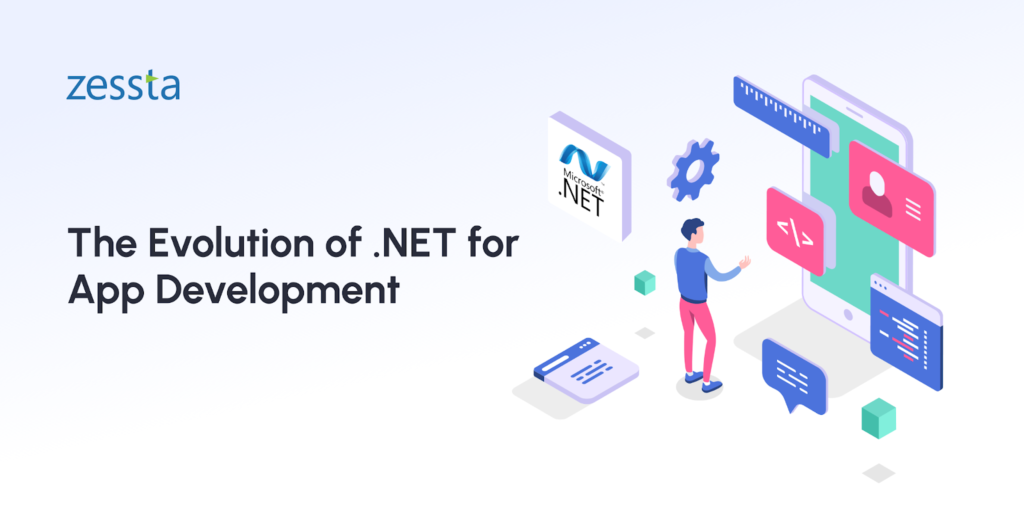The Evolution of .NET for App Development
The Evolution of .NET for App Development

One of the most popular App development frameworks is .NET, and in 2022 the .NET framework turned 20 years. According to Stack Overflow’s survey, it has been the most popular platform for the past 4 years, and globally, there are more than 5 million dot-net developers.
.NET application development has come a long way, from simple web development to complicated and sophisticated enterprise software. For their application requirements, 23.33% of the top 10,000 websites use ASP.NET development services.
Let’s start by looking at .NET’s development and the different ways it has benefited application development.
The Roots and Development of .NET: On February 13, 2002,.NET was introduced to meet the demands of the internet revolution; It had several features required to build the finest applications, like libraries, APIs, support for different languages, one runtime, and many others.
The following describes how .NET application development services have changed over time:
.NET’s launch: Windows-only software: When it first debuted,.NET was designed exclusively for Windows to develop software on and for the Windows operating system. Businesses used to employ dot net developers to create software that could be run on Windows, and interactive programs could be easily created.
Finding Inspiration with ASP.NET MVC: Nobody would have considered working with an ASP.NET development company in 2008 when Ruby Rails was extremely popular. This scenario inspired the creation of the Nuget repository and ASP.NET MVC Via ASP.NET MVC’s features, making web development simpler.
Transparency through open-sourcing ASP.NET MVC: Microsoft made the ASP.NET MVC web framework open-source in 2012 by allowing contributions. It was a huge milestone since the framework could now incorporate the thoughts and perceptions of developers from every angle. As a result, the framework’s performance significantly improved.
Transformation to cross-platform: .NET for everyone: At the Red Hat DevNation conference in 2016, the Microsoft team unveiled the initial iteration of the open-source .NET framework. That was the early days of the cross-platform era, and running on Linux was how .NET had established itself.
Creating the Future:.NET 6 and .NET 7: In November 2021, .NET 6 was released, bringing about significant changes to the framework. With investments in C# 10 and basic APIs, there is a single set of base libraries and SDK, a streamlined development experience, great productivity with hot reload, and much more.
The quickest .NET version to date is .NET 6. The first version of.NET 7 preview, released in February 2022, offers new APIs, ongoing JIT compiler optimizations, annotations to support nullability, and support for more hot reload scenarios.
Why.NET is used by Enterprises in 2023: Businesses use .NET development services like Samsung, JP Morgan Chase, Intel, Microsoft, and other enormous corporates. The framework provides amazing possibilities for developing enterprise applications. A .NET development company can help create simple to complicated software, from functional user experiences to interactive dashboards.
With new features in .NET 6 and .NET 7 preview 1, the developer community will be enchanted by .NET in 2023.
Let’s examine the factors that influence developers’ and businesses’ decisions to engage with a web development company and use the .NET framework in 2023:
Development of Cross-platform: One of its main benefits is that the .NET framework allows for cross-platform programming. .NET developers are available for hire by businesses to work on Windows, Linux, or macOS.
It makes it easier to test the software across various platforms and gives developers the freedom to use whichever system they like. Also, it means that programmers can more affordably create applications for any platform. Additionally, .NET offers ways to run mobile apps on iOS and Android.
Secured .NET’s Apps: High-level security in application development is provided by .NET software development services and is aware of the framework’s security.
The framework has Windows authentication integrated, and additionally, it has cryptography classes that make it simple for developers to encrypt and decrypt private data.
By this, Phishing attacks, SQL injections, and other security vulnerabilities can all be avoided by various security techniques.
A Wide Range of Library: .NET is one of the most versatile development frameworks, offering many libraries and tools. The NuGet package manager makes finding and implementing these libraries in multiple applications easier.
Integrated Development Environments, such as Visual Studio, offer a full development solution for business software and apps. Nearly every .NET developer admires the framework’s incredible features, which range from development to debugging.
Reliable Performance: Since it is dependable, effective, and scaleable, businesses trust .NET to build apps rapidly, and developers use modern language constructs like generics, Linguistic Integrated Query (LINQ), and asynchronous programming.
Additionally, .NET performs a lot faster than numerous other widely used frameworks. It uses less computer and memory power and responds faster. .NET meets the performance standards defined in the industry for tasks like server-side rendering and database access.
Conclusion
During the past 20 years, .NET has made the dreams of programmers and businesses a reality. It is one of the most sought-after and well-liked frameworks for creating web applications. With the launch of.NET 7 and the dominance of ASP.NET Core in web development, the framework is certain to have another 20 illustrious years.